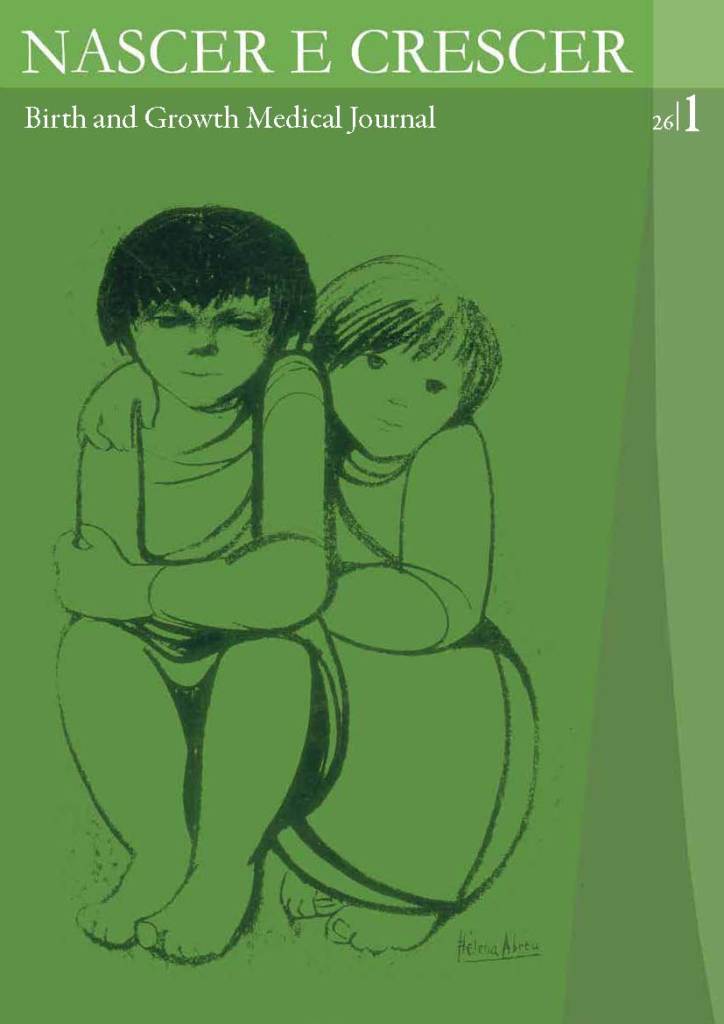CONGENITAL LYMPHEDEMA
DOI:
https://doi.org/10.25753/BirthGrowthMJ.v26.i1.9021Keywords:
Autosomal dominant transmission, congenital lymphedema, hydrocele, Milroy’s disease, recurrent cellulitisAbstract
Background: Primary lymphedema is chronic tissue swelling, most commonly present in lower limbs.
Case: An 1-month-old boy, previously healthy, was admitted with a recent firm edema of the left leg and foot and bilateral hydrocele. No godet signal, other inflammatory signs or joint limitation. He had overlapping fingers and trophic changes of toenails. At 5-months of age did similar edema in the right foot. His great-grandmother had bilateral lower limb edema since childhood. This is consistent with a Milroy disease. Posteriorly, he needed admissions for cellulitis. The ultrasound revealed no vascular changes. No mutation was found in FLT4 gene. He started lymphatic drainage with clear improvement. Currently, he is clinically stable.
Comments/Discussion: Rare disease characterized by anaplasia/hypoplasia of lymphatic vessels and edema of the lower limbs, usually bilateral, other manifestations included hydrocele, recurrent cellulitis and nail changes. It has autosomal dominant transmission, but the mutation is found only in 70% of affected individuals.
Downloads
References
Rodríguez EU, Molpeceres RG, Vázquez MAP, García HG. Linfedema congénito secundario a enfermedad de Milroy. An Pediatr (Barc). 2016. http://dx.doi.org/10.1016/j.anpedi.2015.12.007.
Barral Mena E, Soriano-Ramos M, Pavo García MR, Llorente Otones L, de Inocencio Arocena J. Primary lymphoedema outside the neonatal period. An Pediatr (Barc). 2016. pii:S1695-4033(16)00026-6. doi: 10.1016/j.anpedi.2016.01.016. [Epub ahead of print].
Brice G, Child AH, Evans A, Bell R, Mansour S, Burnand K, et al. Milroy disease and the VEGFR-3 mutation phenotype. J Med Genet 2005;42:98–102.
Kliegman RM, Stanton BF, Geme JWS, Schor NF, Behrman RM Nelson Textbook of Paediatrics. 20th edn. Philadelphia: Elsevier; 2016. p. 621, 622, 892, 1930, 2412-13.
Balboa-Beltran E, Fernández-Seara MJ, Pérez-Muñuzuri A, Lago R, García-Magán C, Couce ML, et al. A novel stop mutation in the vascular endotelial growth factor-C gene (VEGFC) results in Milroy-like disease. J Med Genet. 2014;51:475-8.
Andrade M. Linfangiogénese e genética dos linfedemas: revisão da literatura. J Vasc Bras 2008;7:256-61.
Domínguez-Carrillo LG, Armenta-Flores R, Domínguez-Gasca LG. Linfedema congénito, enfermedad de Milroy. Acta Médica Grupo Ángeles 2011;9:149-54.
Downloads
Additional Files
Published
How to Cite
Issue
Section
License
Copyright and access
This journal offers immediate free access to its content, following the principle that providing free scientific knowledge to the public provides greater global democratization of knowledge.
The works are licensed under a Creative Commons Attribution Non-commercial 4.0 International license.
Nascer e Crescer – Birth and Growth Medical Journal do not charge any submission or processing fee to the articles submitted.


